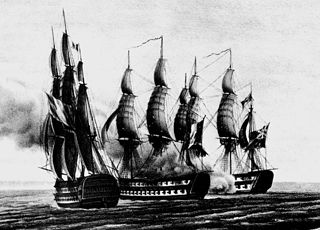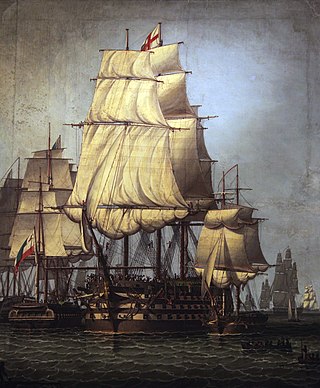
HMS Agincourt was a 64-gun third-rate ship of the line of the Royal Navy, launched on 23 July 1796 at Blackwall Yard, London. The Admiralty bought her on the stocks from the East India Company in 1796, who had called her Earl Talbot.

HMS Minotaur was a 74-gun third-rate ship of the line of the Royal Navy launched on 6 November 1793 at Woolwich. She was named after the mythological bull-headed monster of Crete. She fought in three major battles – Nile, Trafalgar, and Copenhagen (1807) – before she was wrecked, with heavy loss of life, in December 1810.
HMS Renown was a 74-gun third-rate ship of the line of the Royal Navy. She was to have been named HMS Royal Oak, but the name was changed to Renown on 15 February 1796. She was launched at Deptford Wharf on 2 May 1798 and served in 1800-1801 as the flagship of Sir John Borlase Warren, initially in the English Channel.

HMS York was a 74-gun third-rate ship of the line of the Royal Navy, built at Rotherhithe by the contract firm Samuel & Daniel Brent, and launched on 7 July 1807. She saw service during the Napoleonic Wars, though is best known for her time spent as a prison ship. She was broken up in March 1854.

HMS Swiftsure was a 74-gun third rate ship of the line of the British Royal Navy. She spent most of her career serving with the British, except for a brief period when she was captured by the French during the Napoleonic Wars in the action of 24 June 1801. She fought in several of the most famous engagements of the French Revolutionary and Napoleonic Wars, fighting for the British at the Battle of the Nile, and the French at the Battle of Trafalgar.

Tigre was a 74-gun ship of the line of the French Navy. Later it was captured by the British and, as HMS Tigre, operated as part of the Royal Navy throughout the Napoleonic Wars.

HMS Northumberland was a 74-gun third-rate ship of the line of the Royal Navy, built at the yards of Barnard, Deptford and launched on 2 February 1798. She carried Napoleon to his final exile on St Helena.
HMS Stately was a 64-gun third-rate ship of the line of the Royal Navy, launched on 27 December 1784 at Northam.

HMS Hector was a 74-gun third rate ship of the line of the Royal Navy, launched on 27 May 1774 at Deptford.
HMS Ramillies was a 74-gun third rate ship of the line of the Royal Navy, launched on 12 July 1785 at Rotherhithe.

HMS Diadem was a 64-gun third rate ship of the line of the Royal Navy, launched on 19 December 1782 at Chatham. She participated in the Battle of Cape St Vincent in 1797 under Captain George Henry Towry.
HMS Dictator was a 64-gun third-rate ship of the line of the Royal Navy, launched on 6 January 1783 at Limehouse. She was converted into a troopship in 1798, and broken up in 1817.
HMS Kent was a 74-gun third-rate ship of the line of the Royal Navy, launched on 17 January 1798 at Blackwall Yard.

HMS Dragon was a 74-gun third rate ship of the line of the Royal Navy, launched on 2 April 1798 at Rotherhithe. She was designed by Sir William Rule, and was the only ship built to her draught.

HMS Monmouth was a 64-gun third rate ship of the line of the Royal Navy, launched on 23 April 1796 at Rotherhithe. She had been designed and laid down for the East India Company, but the Navy purchased her after the start of the French Revolutionary War. She served at the Battle of Camperdown and during the Napoleonic Wars. Hulked in 1815, she was broken up in 1834.

HMS Queen Charlotte was a 104-gun first-rate ship of the line of the Royal Navy, launched on 17 July 1810 at Deptford. She replaced the first Queen Charlotte sunk in 1800.

HMS Egmont was a 74-gun third rate ship of the line of the Royal Navy, launched on 7 March 1810 at Northfleet.
HMS Chichester was a 70-gun third rate ship of the line of the Royal Navy, designed by Sir Joseph Allin and built by Peirson Lock at Portsmouth Dockyard to the standard draught for 70-gun ships as specified in the 1745 Establishment amended in 1750, and launched on 4 June 1753.

HMS Dido was one of the twenty-seven Enterprise class of 28-gun sixth-rate frigates in service with the Royal Navy during the late eighteenth and early nineteenth centuries. Dido was commissioned in September 1787 under the command of Captain Charles Sandys. She participated in a notable action for which her crew would later be awarded the Naval General Service Medal; her participation in a campaign resulted in the award of another. Dido was sold for breaking up in 1817.
HMS Winchelsea was a 32-gun fifth-rate Niger-class frigate of the Royal Navy, and was the sixth Royal Navy ship to bear this name. She was ordered during the Seven Years' War, but completed too late for that conflict. She cost £11,515-18-0d to build.













